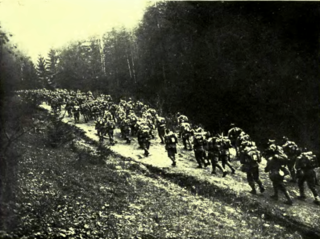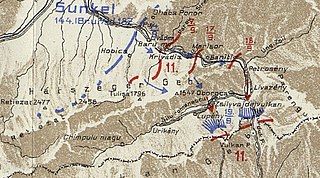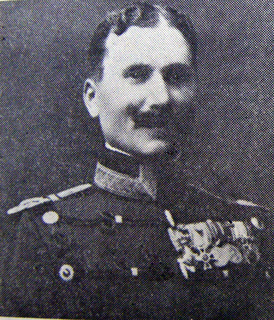
The Battle of Șelimbăr, or Battle of Sellenberk, took place on 18 October 1599 between the Romanian army of Michael the Brave and the Transylvanian-Hungarian army of Andrew Báthory. The battle was fought near the village of Șelimbăr close to Sibiu.

Tălmaciu is a town in Sibiu County, in central Romania, 20 km (12 mi) south of the county seat, Sibiu. It lies on the eastern end of the Mărginimea Sibiului area.

The Battle of Transylvania was the first major operation of the Romanian forces Campaign during World War I, beginning on 27 August 1916. It started as an attempt by the Romanian Army to seize Transylvania, and potentially knock Austria-Hungary out of the war. Although initially successful, the offensive was brought to a halt after Bulgaria's attack on Dobruja. Coupled with a successful German and Austro-Hungarian counterattack which started in mid-September, the Romanian Army was eventually forced to retreat back to the Carpathians by mid-October. The Romanian armies however managed to escape the Central Powers' attempts to completely destroy them. The Battle of Transylvania also caused the replacement of the Chief of Staff of the German Army and the shifting of German attention to the region, causing German offensive operations at Verdun to cease.

Ioan Culcer was a Wallachian-born Romanian military leader and politician. Culcer served as a lieutenant during the Romanian War of Independence (1877–1878) and as a general during the Second Balkan War and World War I. In early 1918, he served as Minister for Public Works in the First Averescu cabinet.

The First Battle of Petrozsény was a military engagement fought between Romanian forces on one side and German forces on the other side. It was part of the 1916 Battle of Transylvania, itself part of the Romanian Campaign of World War I. This was a German attack which drove off the Romanian forces from the Transylvanian coal mining center of Petrozsény. Although a Romanian counterattack a few days later undid most of their gains, the main strategic objective of the Central Powers had been nevertheless achieved.

The Battle of Sălătrucu was a military engagement during the Romanian Campaign of World War I. It took place after the Battle of Transylvania and resulted in a Romanian victory. A mixed Central Powers force – under German leadership but with mostly Austro-Hungarian troops – conducted a failed offensive into Romanian territory, south of the Turnu Roșu Pass.

The Battle of Slatina was a military engagement between Romanian and German forces during World War I. It resulted in a strategic victory for the Romanians.

The Romanian Debacle consisted in a series of battles between November and December 1916 which led to the Central Powers conquest of Bucharest, the capital of Romania. Russian forces joined the Romanians at the start of December.

The Battle of the Olt Valley consisted in a prolonged military engagement during World War I between Romanian forces on one side and Central Powers' forces on the other side. Within just under a month, the Central Powers had managed to conquer the 30 miles (48 km)-long Olt Valley from its Romanian defenders.

The Pitești-Târgoviște Retreat was a fighting-withdrawal operation carried out by the Romanian 1st Army in the face of advancing Central Powers' forces during World War I. The retreat lasted from 29 November to 3 December and culminated in a violent battle at Târgoviște, after which the entire Romanian Army started a general retreat towards Moldavia.

The Second Battle of Petrozsény was a World War I military engagement between Romanian forces on one side and Central Powers forces on the other side. It was part of the wider Battle of Transylvania and resulted in a Romanian victory.

The Battle of Nagybár was a military engagement between Romanian forces on one side and Central Powers forces on the other side. It was part of the 1916 Battle of Transylvania during the Romanian Campaign of World War I. The battle resulted in a Romanian victory.

The Petrozsény Offensive was the opening action of the south-western front of the 1916 Battle of Transylvania, during World War I. The Transylvanian coal-mining center of Petrozsény (Petroșani) was occupied by the Romanian Army on 29 August, two days after the Kingdom of Romania declared war on Austria-Hungary.

The Battle of Mount Csindrel was a World War I military engagement between German and Romanian forces. It was part of the 1916 Battle of Transylvania and resulted in a tactical victory for the Romanians.

The Third Battle of Petrozsény was a World War I military engagement between Romanian forces on one side and Central Powers forces on the other side. It was part of the wider Battle of Transylvania and the last engagement in the area around Petrozsény. The battle resulted in a Central Powers victory.

The Battle of Sellenberk was a World War I military engagement fought between Romanian forces on one side and Central Powers forces on the other side. It was part of the wider Battle of Transylvania and resulted in a Romanian victory.

The Veresmart Offensive was a World War I military engagement between Romanian forces on one side and Central Powers forces on the other side. It was part of the larger Battle of Transylvania. Although the Romanians failed to reach their planned objective, the strategic situation of the Central Powers was significantly worsened by the Romanian attack. Nevertheless, the Romanian forces did not exploit their strategic success further.

David Praporgescu was a Romanian brigadier general during World War I, who was killed in action at the start of the Battle of the Southern Carpathians.

The Battle of Nagyszeben was a World War I military engagement fought between the forces of the Central Powers on one side and the forces of Romania on the other side. It was the decisive engagement during the Battle of Transylvania, and also the largest, involving four armies out of the five fighting in the region: two Romanian, one German, and one Austro-Hungarian.

The Battle of Kolun was a World War I military engagement fought between Romanian and Central Powers forces. It was part of the wider Battle of Transylvania and resulted in a tactical victory for the Central Powers.




















